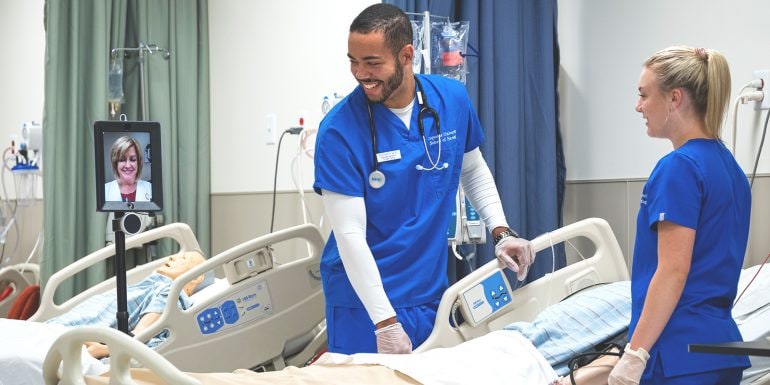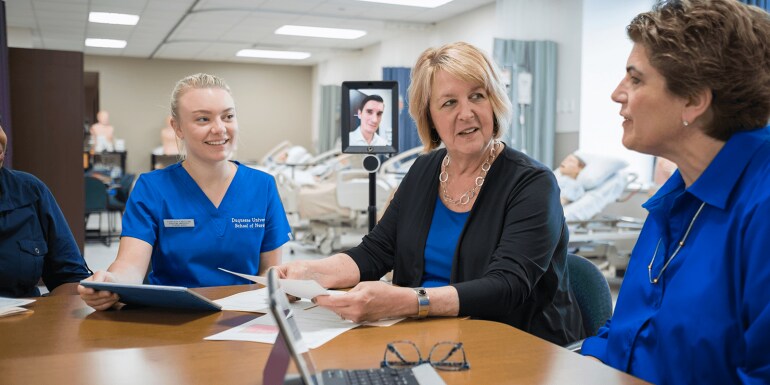
Optimize site conversion rates to increase inquiries and enrollments
A Q&A with Heather Clarke, Associate Director of CRO, Pearson Online Learning Services
Institutions are seeking more inquiries and enrollments from their online learning program websites. Conversion Rate Optimization (CRO) can help them achieve this goal. To explore how, we spoke with Heather Clarke, Associate Director of CRO, Pearson Online Learning Services.
Q: What is CRO (sometimes called website optimization)? How does it relate to marketing online learning programs?
A: CRO is the scientific process of testing for improvements on site elements and a user’s movement towards a purchase decision, with the goal of improving on-site conversions.
I emphasize the word “scientific.” We use the scientific method to collect performance data and user feedback, to form hypotheses, and to test them. Based on data, we create a test variation that we hypothesize will improve performance. By testing with a control, or testing one change at a time, we can attribute any measurable shift in performance to our change.
CRO helps mitigate risks and save time and money. By testing and evaluating (vs. blindly implementing changes), we let learners — through their actions — tell us what works for them and what doesn't.
CRO is continuous. Sites are never 100% optimized. The digital landscape evolves every day. Learners' needs and environments evolve, too. To serve them well, we must keep a pulse on all these changes, and quickly evolve alongside them.
Q: Who should a university leader of an online learning program talk to about CRO, and what questions should they ask?
A: Talk to your marketing team — and first ask if they have a conversion rate optimization team monitoring day-to-day site performance. Then, you’ll want to know:
- What does my online learning audience look like? Who are we targeting?
- What is the data telling us? What pages get the most traffic and prospective students? Why/why not?
- What elements on the site get the most engagement?
- What content is the online learner looking for to decide? Do they need more or less of it? Are they finding it easily?
- Are the pages actionable? Are the calls-to-action (the next steps you want the visitor to take) clear?
- Does our content accurately reflect our online learning program and institution?
Q. How do I judge the conversion rates we’re achieving?
A: Good and bad conversion rates are relative, so there’s no definitive answer. We track baselines and trends to measure success. Our advice: establish a baseline for your site, and constantly strive to improve it.
Once you’ve determined your site’s typical performance (which can vary seasonally), dig into your data, learner behavior, and learner feedback. That's how you identify opportunities to improve.
Q: How can CRO improve performance?
A: CRO’s goal is to find variations of your site that provide a statistically significant improvement in conversion. When you’re regularly making the right content available in a friendlier format, site performance should improve incrementally. More interaction with your forms = more prospective students.
On-site performance is key, but that’s not all that matters. As you get the right decision-making content onto your pages, deliver more relevant information, and help visitors act on it, search engines notice. Your rankings improve. That helps you acquire more learners and decrease acquisition costs.
Q: What tips would you offer to improve conversions?
A: These 6 tips can help you improve significantly:
- Listen to your site's visitors. Do this by drilling down into your data, tracking chat topics and search queries, and surveying/user testing your audience. People will tell you their pain points if you listen. Which leads to...
- Implement the right tracking. The full story is more complicated than just clicks and conversion. To optimize your site’s layout, you need to know how people move through it. What interactive and non-interactive elements are they interacting with? Where in their journey do these interactions happen? In what order do they click on elements? How far do they scroll?
- Simplify, don’t clutter. Focus again on your site’s goal and what learners are telling you. What information do they need before moving forward, and what is your call-to-action? Make it easy for them to get that information. Don’t overload their senses when your page loads.
- Create experiences that reflect your knowledge of the learner's journey. You don’t have to do 1:1 personalization, but if you know someone has visited you before, they may need different information to move forward. If they've clicked from a specific campaign, what they see should relate to it. Mobile and desktop users are different, and may need different information. Beyond this, while it’s challenging to link on-site behavior with offsite data via a larger Customer Relationship Management (CRM) database, doing so can take your on-site targeting to the next level.
- Don’t make people dig! Your most important content should be higher on the page. Check out your site’s “scroll depth”: how far down the page typical visitors scroll. Anything people need to make a decision should appear above that line. Similarly:
- Content should be quickly digestible. What's the average time on site (or page) for site visitors? If your content takes longer than that to skim, you may lose people. They’re in a hurry — just like you.
CRO is constantly evolving. As Heather Clarke’s team tracks the changing web environment, they continually identify new ways to improve performance. In the meantime, the lessons offered here may well help improve your web page conversions.






